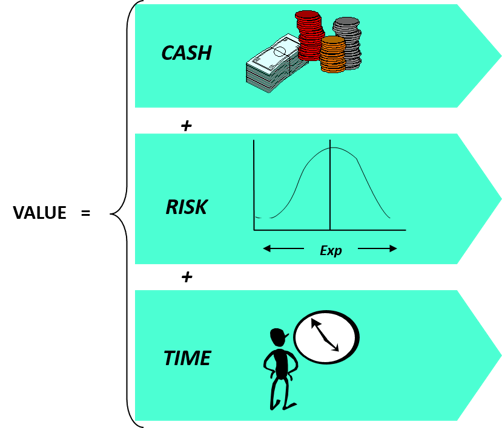by Ashu Bhatia –
When it comes to Information Technology (IT) everyone knows the different questions the executives are interested in:
CEO
- How can I better use IT to deliver shareholder value?
- How can I use IT to deliver on our business strategy?
- Am I spending the right amount on IT?
COO
- How can IT reduce the costs of operation?
- Are there better ways to use technology to become more effective?
- Where should I focus my attention for new capabilities?
CFO
- How do we get a return on our invested IT capital?
- How do I measure the value and results from IT?
- What IT assets do I need to own?
The term “Value” is used so much in business and never completely understood. What is value anyway? Value at the highest level has 3 components:
- How much cash will the company generate? How much cash injection will it need?
- How certain is the cash generation and realization of the investment?
- When will cash be generated? When will value be harvested?

Measuring and communicating the business value of IT remains one of the biggest challenges for CIOs. The major challenges in assessing business value of IT are:
- Difficult to separate value achieved from other improvements (organizational, process redesign, etc.)
- Measuring value is often subjective
- Practices for monitoring/inspecting and communicating value are seldom underappreciated
To really understand what a project’s value is to the firm and then did it ever deliver that value, there is some focus needed on:
- Value Identification – Identifies what the sources of value are from IT, that can be used to deliver business benefit
- Value Capturing – Identifies to what extent new IT initiatives are explicitly tracked and benefit realization for the initiatives
- Value Delivery – Formalizes the expectations set between the business and IT, both in terms of value and relationship
- Value Measurement – This capability defines how the success of an IT organization will be measured
Value should be measured against business capability measures, those that can be directly quantified into financial measures. Measures should be developed jointly by the business and IT, then aligned with business capabilities. For business cases, benefits should be quantified and aligned with the capability measures for the impacted capabilities. Value Management is a journey and becomes the generation of Change Management. The components to do this are:
- A business case framework to define and quantify benefits captured from investments (Templates/ Model)
- A methodology to measure benefit realization against management expectations for investments and report performance (Process)
- A sustainable discipline to enable better decisions in terms of future project prioritization and investments (Governance)

Some of the best practices:
- Think of the Shareholder Value Tree for your project- always try to get a helicopter view of the situation
- Value should be measured against business capability measures, those that can be directly quantified into financial measures. For business cases, benefits should be quantified and aligned with the capability measures for the impacted capabilities
- Incorporate Benefits Realization as a work stream. Include checkpoints in project lifecycle for monitoring value during implementation
- Partner with the business to discuss value in the language that stakeholders want and then drive business results
- Define the right metrics you need to track for
- Behavior Modifier — Aligns employees with the IT organization’s goals and objectives in a manner that motivates employees and influences desired behaviors
- Accountability for Results — Holds managers accountable for results and forces them to direct value to the business
- Performance Orientation — Shows what the performance of the IT organization “has been” and “where it is headed to” – and where to focus management attention. Shifts focus from reactive to proactive management`
- Vision Connected — Quantifiable statement of the IT organization’s “to-be” state or vision




